2017 MERCEDES-BENZ E43AMG load capacity
[x] Cancel search: load capacityPage 104 of 482
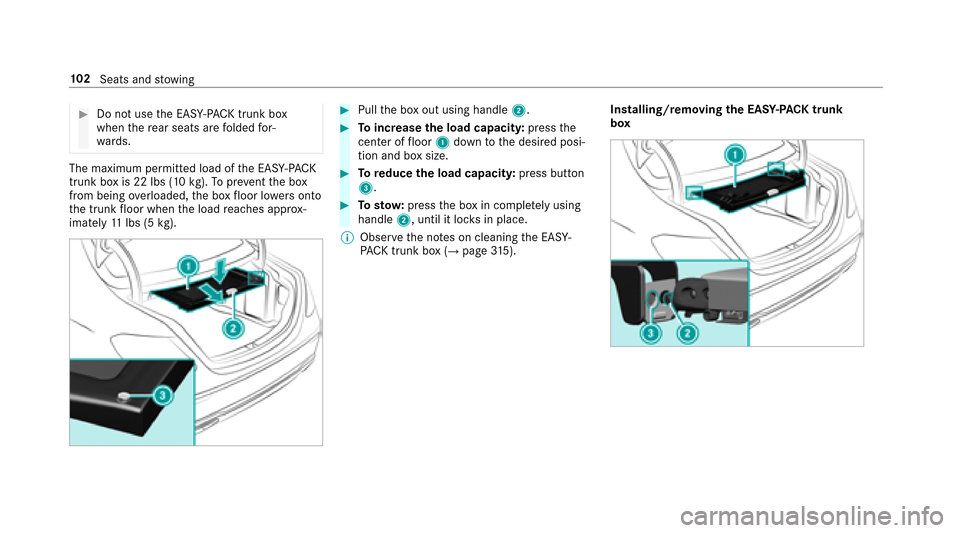
#Do not usethe EA SY-PAC K trunk box
when there ar seats are folded for‐
wa rds.
The maximum permitted load of the EA SY-PAC K
trunk box is 22 lbs (10 kg).To prev ent the box
from being overloaded, the box floor lo wersonto
th e trunk floor when the load reaches appr ox‐
imately 11lbs (5 kg).
#Pull the box out using handle 2.
#Toincrease the load capacit y:press the
center of floor 1down tothe desired posi‐
tion and box size.
#To reduce the load capacity: press button
3.
#To sto w:press the box in comple tely using
handle 2, until it loc ksin place.
% Obser vethe no tes on cleaning the EA SY-
PA CK tr unk box (
→page 315). Installing/removing
the EAS Y-PA CK trun k
bo x
10 2
Seats and stowing
Page 349 of 482
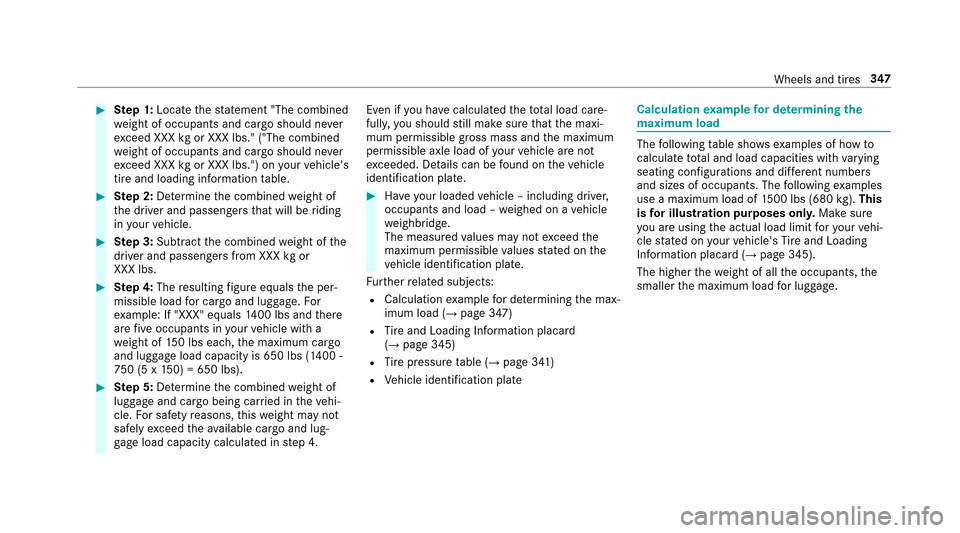
#Step 1: Locate thest atement "The combined
we ight of occupants and cargo should ne ver
exc eed XXX kgor XXX lbs." ("The combined
we ight of occupants and cargo should ne ver
exc eed XXX kgor XXX lbs.") on your vehicle's
tire and loading information table.
#Ste p 2: Determ ine the combined weight of
th e driver and passengers that will be riding
in your vehicle.
#Ste p 3: Subtract the combined weight of the
driver and passengers from XXX kgor
XXX lbs.
#Ste p 4: Theresulting figure equals the per‐
missible load for cargo and lug gage .Fo r
ex ample: If "XXX" equals 1400 lbs and there
are five occupants in your vehicle with a
we ight of 150 lbs each, the maximum cargo
and luggage load capacity is 650 lbs (1400 -
75 0 (5 x 150) = 650 lbs).
#Ste p 5: Determ ine the combined weight of
luggage and cargo being car ried in theve hi‐
cle. For saf etyre asons, this we ight may not
safely exceed theav ailable cargo and lug‐
ga ge load capacity calculated in step 4. Even if
you ha vecalculated thetot al load care‐
full y,yo u should still make sure that the maxi‐
mum permissible gross mass and the maximum
permissible axle load of your vehicle are not
exc eeded. De tails can be found on theve hicle
identification plate.
#Ha ve your loaded vehicle – including driver,
occupants and load – weighed on a vehicle
we ighbridge.
The measured values may not exceed the
maximum permissible values stated on the
ve hicle identification plate.
Fu rther related subjects:
RCalculation example for de term ining the max‐
imum load (→page 347)
RTi re and Loading Info rmation placard
(→page 345)
RTi re pressure table (→page 341)
RVe hicle identification plate
Calculation example for de term ining the
ma ximum load
The following table sho wsexamples of how to
calculate tota l and load capacities with varying
seating con figurations and dif fere nt numbe rs
and sizes of occupants. The following examples
use a maximum load of 1500 lbs (680 kg).This
is for illustration purposes on ly.Make sure
yo u are using the actual load limit foryo ur vehi‐
cle stated on your vehicle's Tire and Loading
Info rmation placard (
→page 345).
The higher thewe ight of all the occupants, the
smaller the maximum load for lug gage .
Wheels and tires 34
7
Page 355 of 482
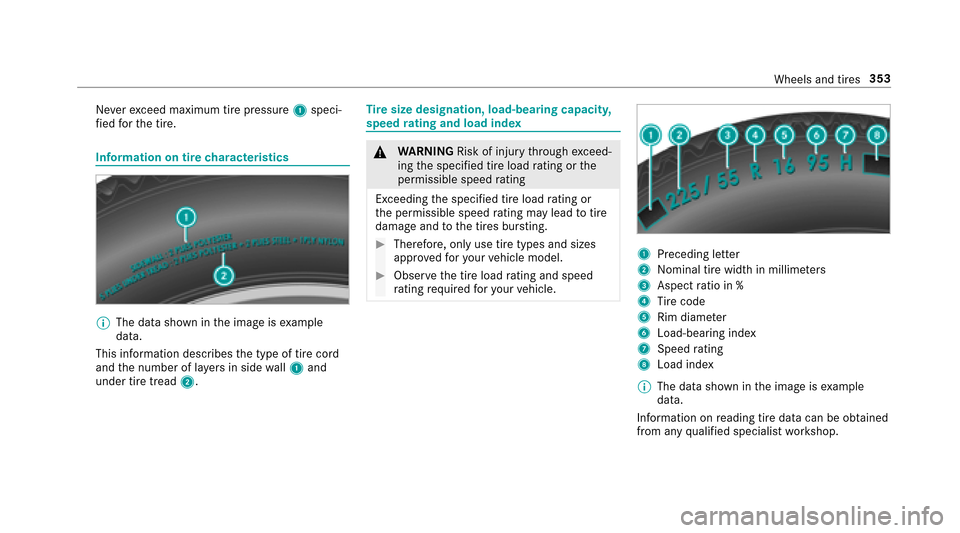
Neverexc eed maximum tire pressure 1speci‐
fi ed forth e tire.
Information on tire characteristics
%
The data shown in the image is example
data.
This information descri besthe type of tire cord
and the number of la yers in side wall1 and
under tire tread 2.
Tire size designation, load-bearing capacity,
speed rating and load index
&
WARNING Risk of injury thro ugh exceed‐
ing the specified tire load rating or the
permissible speed rating
Exceeding the specified tire load rating or
th e permissible speed rating may lead totire
damage andtothe tires bur sting.
#Therefore, only use tire types and sizes
appr ovedfo ryo ur vehicle model.
#Obser vethe tire load rating and speed
ra ting requ ired foryo ur vehicle.
1Preceding letter
2Nominal tire width in millime ters
3Aspect ratio in %
4Tire code
5Rim diame ter
6Load-bearing index
7Speed rating
8Load ind ex
% The data shown in the image is example
data.
Info rmation on reading tire data can be obtained
from any qualified specialist workshop.
Wheels and tires 353
Page 356 of 482
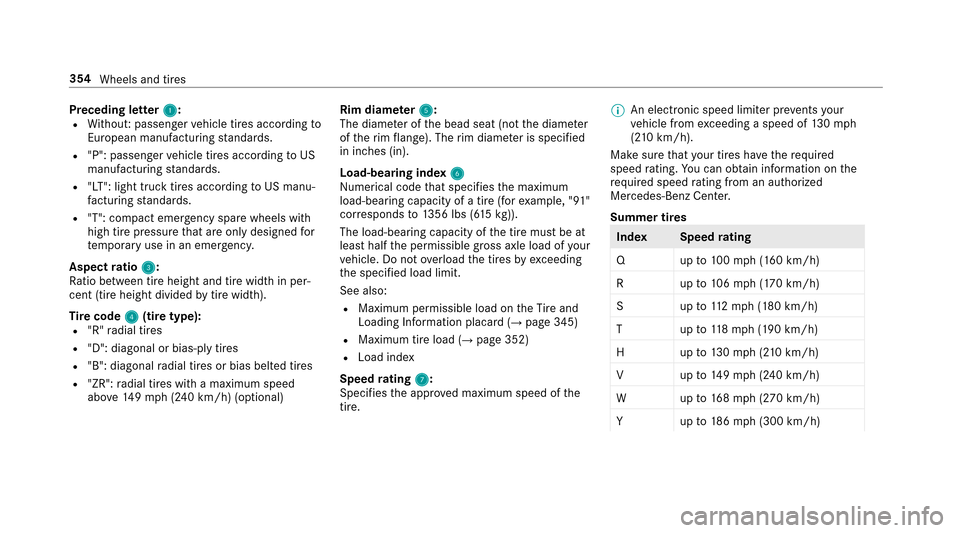
Preceding letter1:RWithout: passenger vehicle tires according to
European manufactu ring standards.
R"P": passenger vehicle tires according toUS
manufacturing standards.
R"LT": light truck tires according toUS manu‐
fa cturing standards.
R"T": compact emer gency spa rewheels with
high tire pressure that are only designe dfo r
te mp orary use in an emer gency.
Aspect ratio 3
:
Ra tio between tire height and tire width in per‐
cent (ti reheight divided bytire width).
Tire code 4
(tire type):R"R" radial tires
R"D": diagonal or bias-ply tires
R"B": diagonal radial tires or bias belted tires
R"ZR": radial tires with a maximum speed
abo ve149mp h(2 40 km/h) (optional) Rim diame
ter5
:
The diam eter of the bead seat (not the diame ter
of therim flange). The rim diame ter is specified
in inches (in).
Load-bearing index 6
Numerical codethat specifies the maximum
load-bearing capacity of a tire (for example, "91"
cor responds to1356 lbs (6 15kg)).
The load-bearing capacity of the tire must be at
least half the permissible gross axle load of your
ve hicle. Do not overload the tires by exceeding
th e specified load limit.
See also:
RMaximum permissible load on theTire and
Loading Info rmation placard (→page 345)
RMaximum tire load (→page 352)
RLoad ind ex
Speed rating 7
:
Specifies the appr oved maximum speed of the
tire. %
An electronic speed limite r prevents your
ve hicle from exceeding a speed of 130mp h
(2 10 km/h).
Make surethat your tires ha vetherequ ired
speed rating. You can obtain information on the
re qu ired speed rating from an au thorized
Mercedes-Benz Center.
Summer tires
Inde xS peedrating
Qu pto 100mp h (160 km/h)
Ru pto 106mp h (170 km/h)
Su pto 112mp h(1 80 km/h)
Tu pto 118mp h (190 km/h)
Hu pto 130mp h(210 km/h)
Vu pto 149mp h(2 40 km/h)
Wu pto 168mp h (270 km/h)
Yu pto 186mp h(3 00 km/h)
354
Wheels and tires
Page 358 of 482
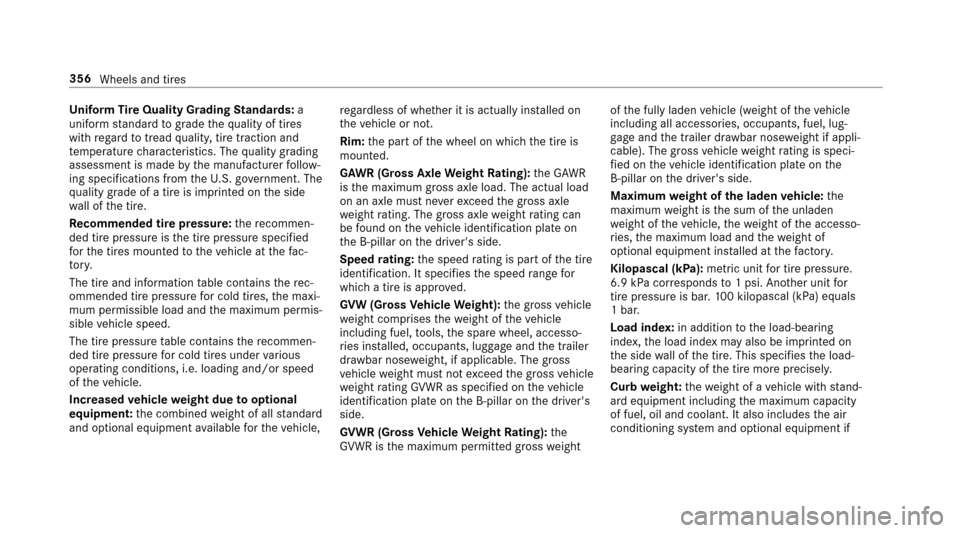
Uniform Tire Quality Grading Standards: a
uniform standard tograde thequ ality of tires
with rega rd totread quality, tire traction and
te mp erature characteristics. The quality grading
assessment is made bythe manufacturer follow‐
ing specifications from theU. S. go vernment. The
qu ality grade of a tire is imprinted on the side
wa ll of the tire.
Re commended tire pressure :th ere commen‐
ded tire pressure is the tire pressure specified
fo rth e tires mounted totheve hicle at thefa c‐
to ry.
The tire and information table conta insthere c‐
ommended tire pressure for cold tires, the maxi‐
mum permissible load and the maximum permis‐
sible vehicle speed.
The tire pressure table conta insthere commen‐
ded tire pressure for cold tires under various
operating conditions, i.e. loading and/or speed
of theve hicle.
Increased vehicle weight due tooptional
equipment: the combined weight of all standard
and optional equipment available forth eve hicle, re
ga rdless of whe ther it is actually ins talled on
th eve hicle or not.
Rim: the part of the wheel on which the tire is
mounted.
GA WR (Gross Axle Weight Rating): the GAWR
is the maximum gross axle load. The actual load
on an axle must ne verexc eed the gross axle
we ight rating. The gross axl e
we ight rati
ng can
be found on theve hicle identification plate on
th e B‑pillar on the driver's side.
Speed rating: the speed rating is pa rtof the tire
identification. It specifies the speed range for
which a tire is appr oved.
GV W (Gross Vehicle Weight): the gross vehicle
we ight comprises thewe ight of theve hicle
including fuel, tools, the spare wheel, accesso‐
ri es ins talled, occupants, luggage and the trailer
dr aw bar nose weight, if applicable. The gross
ve hicle weight must not exceed the gross vehicle
we ight rating GVWR as specified on theve hicle
identification plate on the B‑pillar on the driver's
side.
GV WR (Gross Vehicle Weight Rating): the
GV WR is the maximum permitted gross weight of
the fully laden vehicle (weight of theve hicle
including all accessories, occupants, fuel, lug‐
ga ge and the trailer dr awbar nose weight if appli‐
cable). The gross vehicle weight rating is speci‐
fi ed on theve hicle identification plate on the
B‑pillar on the driver's side.
Maximum weight of the laden vehicle: the
maximum weight is the sum of the unladen
we ight of theve hicle, thewe ight of the accesso‐
ri es, the maximum load and thewe ight of
optional equipment ins talled at thefa ctor y.
Kilopascal (kPa): metricunit for tire pressure .
6.9 kPa cor responds to1 psi. Ano ther unit for
tire pressure is bar.100 kilop ascal (kPa
) equals
1 bar.
Load index: in additiontothe load-bearing
index, the load index may also be imprinted on
th e side wall of the tire. This specifies the load-
bearing capacity of the tire more precisel y.
Curb weight: thewe ight of a vehicle with stand‐
ard equipment including the maximum capacity
of fuel, oil and coolant. It also includes the air
conditioning sy stem and optional equipment if
356
Wheels and tires
Page 359 of 482
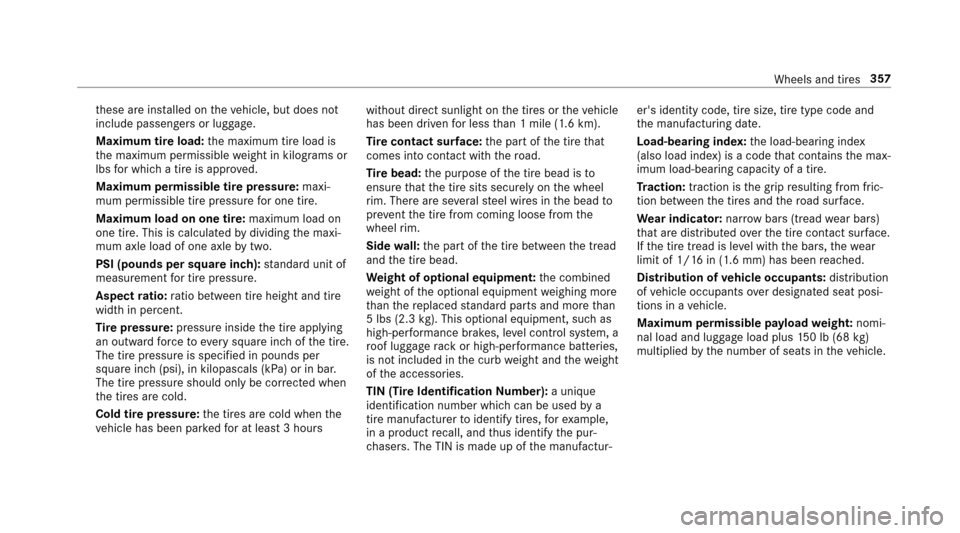
these are ins talled on theve hicle, but does not
include passengers or luggage.
Maximum tire load: the maximum tire load is
th e maximum permissible weight in kilog rams or
lbs for which a tire is appr oved.
Maximum permissible tire pressure: maxi‐
mum permissible tire pressure for one tire.
Maximum load on one tire: maximum load on
one tire. This is calculated bydividing the maxi‐
mum axle load of one axle bytwo.
PSI (pounds per square in ch):standard unit of
measurement for tire pressure .
Aspect ratio: ratio between tire height and tire
width in pe rcent.
Ti re pressure: pressure inside the tire applying
an outward forc eto eve rysquare inch of the tire.
The tire pressure is specified in pounds per
square inch (psi), in kilopascals (kPa) or in bar.
The tire pressure should only be cor rected when
th e tires are cold.
Cold tire pressure: the tires are cold when the
ve hicle has been par kedfo r at least 3 hours without direct sunlight on
the tires or theve hicle
has been driven for less than 1 mile (1.6 km).
Ti re contact sur face: the part of the tire that
comes into con tact wi th thero ad.
Ti re bead: the purpose of the tire bead is to
ensure that the tire sits securely on the wheel
ri m. There are se veralst eel wires in the bead to
pr eve nt
the t
ire from coming loose from the
wheel rim.
Side wall:the part of the tire between the tread
and the tire bead.
We ight of optional equipment: the combined
we ight of the optional equipment weighing more
th an there placed standard parts and more than
5 lbs (2.3 kg).This optional equipment, such as
high-per form ance brakes, le vel control sy stem, a
ro of luggage rack or high-per form ance batte ries,
is not included in the curb weight and thewe ight
of the accessories.
TIN (Tire Identification Number): a unique
identification number which can be used bya
tire manufactu rerto identify tires, forex ample,
in a product recall, and thus identify the pur‐
ch asers. The TIN is made up of the manufactur‐ er's identity code, tire size, tire type code and
th
e manufacturing date.
Load-bearing index: the load-bearing index
(also load index) is a code that con tains the max‐
imum load-bearing capacity of a tire.
Tr action: traction is the grip resulting from fric‐
tion between the tires and thero ad sur face.
We ar indicator: narrow bars (tread wear bars)
th at are distributed overth e tire conta ct surface.
If th e tire tread is le vel with the bars, thewe ar
limit of 1/ 16in (1.6 mm) has been reached.
Distribution of vehicle occupants: distribution
of vehicle occupants
over design
ated seat posi‐
tions in a vehicle.
Maximum permissible pa yload weight: nomi‐
nal load and luggage load plus 150 lb (68 kg)
multiplied bythe number of seats in theve hicle.
Wheels and tires 357
Page 362 of 482

Observethefo llowing when selecting, mounting
and replacing tires:
ROnly use tires and wheels of the same type
(summer tires, winter tires, MOEx tended
tires) and the same make.
ROnly mount wheels of the same size on one
axle (left and right).
It is only permissible todeviate from this rule
in theeve nt of a flat tire in order todrive to
th e specialist workshop.
ROnly mount tires of the cor rect size onto the
wheels.
RVe hicles with a tire pressure monitoring
sy stem: All mounte d wheels must be equip‐
ped with functioning sensors forth e tire
pressure monitoring sy stem.
RAt temp eratures below 45 °F (7 °C), use win‐
te r tires or all-season tires mar ked M+S for
all wheels.
Wi nter tires bearing thei snowflake sym‐
bol in addition tothe M+S marking pr ovide
th e best possible grip in wintry road condi‐
tions.
RFo r M+S tire , onlyuse tires with the same
tread.
RObser vethe maximum permissible speed for
th e M+S tire mounted.
If th is is below theve hicle's maximum speed,
th is must be indicated in an appropriate label
in the driver's field of vision.
RBreak in new tires at moderate speeds for
th efirs t 60 miles (100 km).
RRe place the tires af ter six years at the latest,
re ga rdless of wear.
RWhen replacing with tires that do not fea‐
ture run-flat characteristics: Vehicles with
MOExtended tires are not equipped with a
TIREFIT kit at thefa ctor y.Equip theve hicle
with a TIREFIT kit af terre placing with tires
th at do not feature run-flat characteristics,
fo rex ample winter tires.
Fo r more information on wheels and tires, con‐
ta ct a qualified specialist workshop.
Be sure toalso observ eth efo llowing fur ther
re lated subjects:
RNo tes on tire pressure (→page 339)
RTire and Loading Info rmation placard
(→page 345)
RTi re size designation, load-beari ng capacity,
speed rating and load ind ex(→page 353)
RTire pressure table (→page 341)
Note s on inter changing wheels
&
WARNING Risk of injury thro ugh dif fer‐
ent wheel sizes
Inter changing the front and rear wheels if the
wheels or tires ha vediffere nt dimensions
may se verely impair the driving characteris‐
tics.
The wheel brakes or wheel suspension com‐
ponents may also be damaged.
#Ro tate front and rear wheels only ifth e
wheels and tires are of the same dimen‐
sions.
360 Wheels and tires
Page 380 of 482

1Warning symbols
2Re frigerant filling capacity
3Applicable standards
4PA G oil part number
5Re frigerant type
Wa rning symbols 1advise you about:
RPo ssible dangers
RHaving service workcar ried out at a qualified
specialist workshop Re
frigerant filling capacity
Fi lling capacity forre frigerant and PAG oil
Model Refrigerant
All models2 2.2 ± 0.4 oz
(630 ± 10g)
Model PAG oil
All models2 .8 ± 0.4 oz
(80 ± 10g)
Vehicle data
Vehicle dimensions
The heights specifi ed mayvary as a result of the:
RTire s
RLoad
RCondition of the suspension
ROptional equipment
Opening height
Model
1Opening
height
E 300 72.4 in
(1839 mm)
All other models 72.7 in
(1 84 6 mm)
37 8
Tech nical da ta